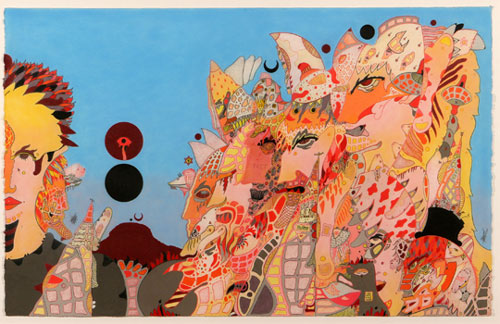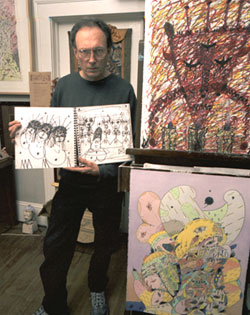
William Fields started having visions of alien spirits when he was seven years old and living in a house with his mother and grandparents in Winston-Salem, North Carolina.
Now, sixty years later, Fields is living in the same house in which he grew up (he moved back about seventeen years ago), creating art full time, and welcoming the visions that continue to inspire his practice.
As a child, Fields wasn’t fearful of the spirits that appeared, spoke to him, and took him outside of his body, but he did wonder if their arrival meant he was crazy, and therefore didn’t tell anyone about the regular occurrences.
In time, his tendency to drift off raised the concern of teachers — Fields remembers being labeled a “dreamer” — and he was sent to a psychiatrist. He recalls with gratitude his doctor being young and open-minded enough to validate and even help name the experiences as “out of body” (not part of the lexicon for a young, white, Southern Baptist boy in the mid-20th century).
Fields continues to employ the psychiatrist’s wording to describe what it feels like to detach from his body and float through the house and neighborhood, looking back at his earthly form from a distant aerial vantage point.
Speaking to me on the phone from North Carolina, Fields’ slow, Southern intonation is pleasingly incongruous as he details his lifelong exploration of occult practices and beliefs. He is at once unapologetic in his unconventionality and sweetly gracious when I ask him to spell the difficult name of his Indian guru and innumerable other spiritual teachers, poets, and artists that influence his art and life.
Most [of the represented spirits] are Mercury spirits. They have their own unique physical shapes, but no being or spirit stays in one form forever. Everything is constantly changing or transforming.
Without much in the way of a formal education, Fields is a voracious autodidact and seeker who does not limit himself to a singular path. The alien spirits, as he considers them, that first visited him in early childhood and returned in adulthood inspired Fields to study a great many beliefs and traditions, and today his practice incorporates teachings from Tibetan Buddhism, Egyptian mythology, Gnostic Christianity, the Kabbalah, Theosophy, hermetic science, pagan goddess worship, and Hinduism.
Fields tells me he was one of the first Southerners to be initiated into Indian mysticism by Swami Haidakhan Babaji, who, upon meeting Fields in person at a gathering in Atlanta, immediately recognized his unique spiritual openness.
Fields’ art is comprised of symbols, hieroglyphs, archetypes, animals, gods, and spirits (or fragments and amalgams there-of) from the many diverse belief systems in which he finds meaning. Often categorized as “outsider” or “folk” art, Fields’ compositions are fantastical with bold use of color and an extraordinary amount of detailing.
The last decade has witnessed Fields’ most impressive output, namely a large and as yet unconcluded body of over one hundred and fifty works grouped together under the title Illuminations, which Fields borrows from the poet Arthur Rimbaud.

Drawn with Prismacolor pencils and pastels on Arches paper in one of two formats, either 22″x30″ vertical or 26″x40″ horizontal, each individual work is conceived from a vision. Though Fields sometimes requests the presence of specific spirits by calling to them with chanting, prayers, and meditation, many come to him without invitation (guru Babaji, for instance, appears regularly in Fields’ home).
While communing with spirits in the ecstatic state of a vision — which lasts about two hours — Fields perceives the subject of the composition as well as its formal qualities and color palette. From inception, each work takes as long as three months to complete.
Hermetica (shown above), a horizontal piece from 2005, provides a wonderfully vivid example of Fields’ latest creations. Set against a cloudless cyan sky, a jumble of spirit figures crowd the front of the picture plane in saturated oranges, reds, pinks, and yellows.
In his characteristic way, Fields achieves dimension and perspective not through color gradation and shading but by building layers upon layers of sharply defined color blocks and patterns.
The result is less a narrative tale than an impossibly complex map of symbols. At least eight faces are decipherable — sometimes more — as they overlap and merge into and out of each other with extra eyes, limbs, and horns left unaccounted. Within and around the undulating heap of spirit faces are more abstract organic shapes and patterns that resemble sub-dividing cells and peacock feathers.
On the far left side of the composition, a solitary figure is cut off. It looks back at the viewer with the one eye that is captured in the frame; a feathered headdress, ram’s nose, and pharaoh’s beard obscure its human-esque face.
